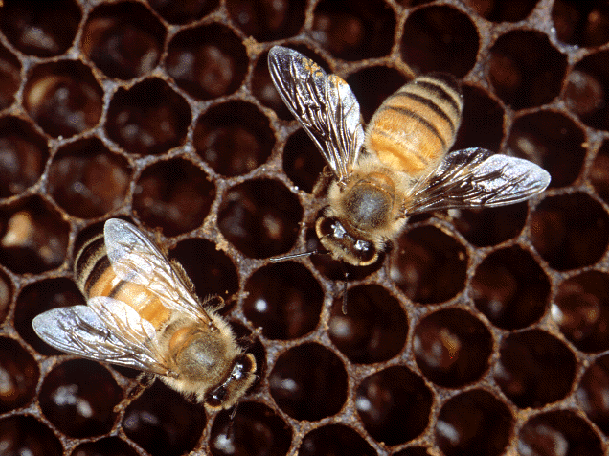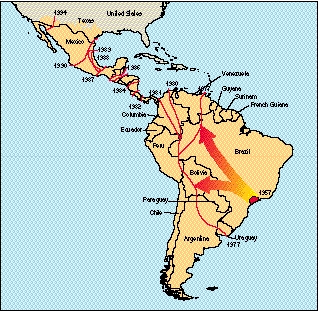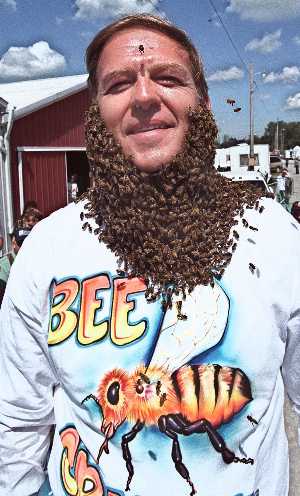| |
| สยามเมื่อกาลก่อน หรือประเทศไทยในปัจจุบัน เป็นหนึ่งในกลุ่มประเทศของเอเชียตะวันออกเฉียงใต้ ตั้งอยู่บนคาบสมุทรอินโดจีน ซึ่งมีประเทศอินเดียทางทิศตะวันตกและ จีนทางทิศตะวันออก ประเทศไทยมีพรมแดนด้านทิศตะวันออกจรดลาวและเขมร ทางใต้จรดอ่าวไทยและมาเลเชีย ฝั่งตะวันตกจรดทะเลอันดามันและพม่า มีพื้นที่ประมาณ 200,148 ตารางไมล์ หรือประมาณ 514,000 ตารางกิโลเมตร มีประชากรรวมทั้งสิ้นประมาณ 62,418,054 คน (จากข้อมูลสถิติประชากรปี 2548 กรมการปกครอง กระทรวงมหาดไทย) "สยาม" คือชื่อเดิมของประเทศไทย ซึ่งเคยใช้เรียกอย่างเป็นทางการ จวบกระทั่ง*วันที่ 17 เดือน กันยายน พ.ศ. 2483 (ค.ศ. 1940) ในสมัยของรัฐบาลหลวงพิบูลสงคราม จึงได้เปลี่ยนชื่อจาก"ประเทศสยาม" เป็น "ประเทศไทย" ทั้งในภาษาไทยและภาษาต่างประเทศ และในปีพ.ศ.2483 นี้ ด้วยเช่นกันที่รัฐบาลของหลวงพิบูลฯ ได้ประกาศยกเลิกการใช้วันที่ 31 มีนาคมเป็นวันสิ้นปี และวันที่ 1 เมษายน เป็นวันขึ้นปีใหม่ เพื่อให้เข้ากับสากลนิยม จึงประกาศให้วันที่ 31 ธันวาคมเป็นวันสิ้นปี และวันที่ 1 มกราคม เป็นวันขึ้นปีใหม่ นับแต่บัดนั้นเป็นต้นมา (จากหนังสือ เจ้าชีวิต-สยามก่อนยุคประชาธิปไตย พระนิพนธ์ พระเจ้าวรวงศ์เธอ พระองค์เจ้าจุลจักรพงษ์) ประเทศไทยปกครองด้วยระบอบประชาธิปไตย โดยมีพระมหากษัตรย์ทรงเป็นประมุขตั้งแต่ปี พ.ศ. 2475 เมื่อกลุ่มบุคคลที่เรียกว่า คณะราษฎร ได้ยึดอำนาจการปกครองของประเทศ แล้วเปลี่ยนเป็นการปกครองตามระบอบประชาธิปไตย จากการปกครองแบบเดิม ที่มีอยู่นับแต่กรุงสุโขทัยเป็นราชธานี ต่อมาถึงกรุงศรีอยุธยา กรุงธนบุรี และกรุงรัตนโกสินทร์ ซึ่งมีสถาบันพระมหากษัตริย์เป็นแกนกลาง เป็นศูนย์อำนาจ เรียกว่าระบอบสมบูรณาญาสิทธิราชย์ ก่อนกรุงศรีอยุธยาจะแตกในปี พ.ศ. 2310 นั้นพม่าได้ยกทัพมาล้อมกรุงศรีอยุธยาตั้งแต่ปี พ.ศ.2308 พระยาตากซึ่งเป็นเจ้าเมืองตากอยู่ถูกเรียกเข้ามาช่วยป้องกันกรุงศรีอยุธยา ในเดือนมกราคม พ.ศ. 2310 พระยากตากได้นำทหารราว 1,000 คน ตีฝ่าด่านพม่าหนีออกจากกรุงศรีอยุธยาไปรวบรวมผู้คนไว้สู้พม่าที่เมืองจันทบูรณ์ในที่สุดกรุงศรีอยุธยาก็ถูกพม่าตีแตกเมื่อวันที่ 7 เมษายน พ.ศ. 2310 พระยาตากได้รวบรวมผู้คนอยู่จนถึงเดือนพฤศจิกายนปีเดียวกันนั้นก็ยกทัพกลับมาตีทัพพม่าที่ตั้งมั่นอยู่ที่ค่ายโพธิสามต้น อยุธยา และตีค่ายพม่าแตกเมื่อวันที่ 6 พฤศจิกายน พ.ศ. 2310 พม่าถูกฆ่าตายเป็นอันมากที่รอดตายก็แตกพ่ายหนีกลับพม่าไป พระยาตากจึงได้กลายเป็นผู้นำคนสำคัญของประเทศในขณะนั้นและเลือกกรุงธนบุรีเป็นเมืองหลวง พระเจ้าตากสินมหาราชทรงครองราชย์ ระหว่าง ปี พ.ศ. 2310 ถึงปี พ.ศ. 2325 พระบาทสมเด็จพระพุทธยอดฟ้าจุฬาโลก ทรงสถาปนากรุงเทพขึ้นเป็นเมืองหลวง เมื่อ พ.ศ. 2325 (ครองราชย์ 6 เมษายน พ.ศ. 2325-8 กันยายน พ.ศ.2332) รัชกาลที่ 1 แห่งกรุงรัตนโกสินทร์ เมื่อขึ้นครองราชย์แล้วได้สถาปนาสมเด็จพระอนุชา (พระนามเดิมบุญมา) เป็นกรมพระราชวังบวรมหาสุรสิงหนาทพระมหาอุปราชซึ่งหมายความว่าจะเป็นผู้สืบราชสมบัติหากรัชกาลที่ 1 สวรรคต สมเด็จพระพุทธยอดฟ้าฯ และกรมพระราชวังบวรมหาสุรสิงหนาทได้ร่วมต่อสู้ศัตรูนอกประเทศเคียงบ่าเคียงไหล่กันมาโดยตลอด แต่ในระยะหลังเกิดความขัดแย้งกันหลายเรื่องจนถึงเกือบจะสู้รบกัน ความบาดหมางยังมีอยู่จนเมื่อกรมพระราชบวรฯสิ้นพระชนม์ด้วยพระโรคนิ่วเมื่อปี พ.ศ. 2345 (เมื่อรัชกาลที่ 1 ครองราชย์มาแล้ว 11 ปี) หลังจากกรมพระาชวังบวรสิ้นพระชนม์ปรากฏว่าพระโอรสสองพระองค์ของกรมพระราชวังบวรชื่อพระองค์เจ้าลำดวนและพระองค์เจ้าอินทปัตได้ถูกกล่าวหาว่าคบคิดกับพระยาเกษตราธิบดีจะทำการกบฎ จึงได้มีรับสั่งให้ประหารชีวิตผู้สมรู้ร่วมคิดทุกคนรวมทั้งพระองค์เจ้าทั้งสองพระองค์ เมื่อวังหน้าหรือกรมพระราชวังบวรสิ้นพระชนม์แล้ว รัชการที่ 1 ได้ทรงโปรดตั้งเจ้าฟ้ากรมหลวงอิศรสุนทร พระเจ้าลูกยาเธอองค์ใหญ่ขึ้นเป็นมหาอุปราช (วังหน้า) เมื่อ พ.ศ. 2350 รัชกาลที่ 1 ครองราชย์นานถึง 28 ปี สิ้นพระชนม์เมื่อ พ.ศ. 2352 พระชนม์มายุ 72 พรรษา ก่อนสวรรคต ได้ทรงมอบราชสมบัติให้แก่มหาอุปราชคือ เจ้าฟ้ากรมหลวงอิศรสุนทร ซึ่งทรงตั้งให้เป็นมหาอุปราชอยู่ก่อนแล้ว รัชกาลที่ 2 พระบาทสมเด็จพระพุทธเลิศหล้านภาลัย (ครองราชย์ พ.ศ. 2352-2367)รัชกาลที่ 2 ทรงตั้งพระราชอนุชาคือกรมหลวงเสนานุรักษ์ขึ้นเป็นกรมพระราชวังบวรสถานมงคลที่พระมหาอุปราชหรือวังหน้า กรมพระราชวังบวรสถานมงคลสิ้นพระชนม์เมื่อปี พ.ศ. 2460 หลังจากกรมพระราชวังบวรสถานมงคลสิ้นพระชนม์และรัชกาลที่ 2 ไม่ทรงแต่งตั้งผู้ใดเป็นมหาอุปราชจนสิ้นรัชกาลที่ 2 สิ้นพระชนม์เมื่อปี พ.ศ. 2367 หลังจากทรงประชวรอยู่ 8 วัน โดยมิได้ตรัสมอบราชสมบัติให้แก่ผู้ใด รัชกาลที่3 พระบาทสมเด็จพระนั่งเกล้าเจ้าอยู่หัว (ครองราชย์ พ.ศ. 2367-2394)พระโอรสองค์ใหญ่ของรัชกาลที่ 2 คือกรมหมื่นเษฎาบดินทร์ ประสูติจากเจ้าจอมมารดาเรียมขณะที่รัชกาลที่ 2 สวรรคต กรมหมื่นเษฎาบดินทร์ พระชนม์มายุ 37 พรรษา เนื่องจากพระราชมารดาของพระองค์เป็นคนสามัญจึงมิได้เป็นเจ้าฟ้า รัชกาลที่ 2 ทรงมีพระมเหสี เพียงพระองค์เดียว และมีพระโอรสจากพระมเหสี 2 พระองค์คือ เจ้าฟ้ามงกุฎและเจ้าฟ้าจุฑามณี เมื่อรัชกาลที่ 2 สิ้น พระชนม์นั้นเจ้าฟ้ามงกุฏ ซึ่งมีพระชนมายุ 20 พรรษา เพิ่งจะทรงผนวชอยู่ที่วัดบวรนิเศน์วิหารได้เพียง 7 วัน เนื่องจาก ตอนที่รัชกาลที่ 3 สวรรคตนั้นไม่มีมหาอุปราชหรือวังหน้า เพราะมหาอุปราชสิ้นพระชนม์ไปก่อนแล้ว และรัชกาลที่ 3 ก็ไม่ได้ทรงมอบราชสมบัติแก่ผู้ใดกรมหมื่นเษฎาบดินทร์พระราชโอรสองค์ใหญ่มีพระชนมายุมากกว่าคือ 37 พรรษและมีประสบการณ์ในการบริหารบ้านเมืองมาเป็นเวลานาน ก็มีความเหมาะสมที่จะขึ้นเป็นพระมหากษัตริย์ ส่วนเจ้าฟ้ามงกุฎฯ นั่นทรงเป็นโอรสองค์ใหญ่ ซึ่งเกิดแก่พระมเหสีก็มีความชอบธรรมที่จะได้เป็นพระมหากษัตริย์เหมือนกันขณะนั้นประเทศไทยยังมีพม่าเป็นศัตรูหลัก และกรมหมื่นเษฎาบดินทร์นั้นมีประสบการณ์ในการบริหารราชการมาก จึงได้ขึ้นเป็นพระมหากษัตริย์องค์ที่ 3 แห่งกรุงรัตนโกสินทร์ โดยที่เจ้าฟ้ามงกุฎไม่ทรงลาผนวช ปัญหาความขัดแย้งจึงไม่มี รัชกาลที่ 3 หรือพระบาทสมเด็จพระนั่งเกล้าเจ้าอยู่หัวทรงตั้งให้ กรมหมื่นศักดิ์พลเสพ พระโอรสองค์หนึ่งของรัชกาลที่หนึ่งเป็นพระมหาอุปราชทรงพระนามว่ากรมพระราชวังบวรศักดิ์พลเสพ กรมหมื่นศักดิ์พลเสพมีพระชนม์มายุแก่กว่ารัชกาลที่ 3 อยู่ 2 พรรษา รัชกาลที่ 3 ทรงตั้งกรมหมื่นศักดิ์พลเสพเป็นพระมหาอุปราชด้วยสาเหตุใหญ่ 2 ประการคือ ประการแรกรัชกาลที่ 3 ไม่ทรงมีพระอนุชาร่วมพระราชมารดาและประการที่สองกรมหมื่นศักดิ์พลเสพเคยออกรบร่วมกับรัชกาลที่ 3 เมื่อครั้งยังเป็นกรมหมื่นเจษฎบดินทร์ คงจะพอพระทัยในความสามารถและอุปนิสัยใจคอ อย่างไรก็ดี กรมพระราชวังบวรศักดิ์พลเสพ เป็นพระมหาอุปราชอยู่เพียง 8 ปี ก็ทรงประชวรสิ้นพระชนม์และรัชกาลที่ 3 ซึ่งครองราชย์นานถึง 27 ปี ก็ไม่ทรงตั้งผู้ใดเป็นพระมหาอุปราชหรือวังหน้าอีกจนตลอดรัชกาล ระหว่างการดำรงตำแหน่งของรัชกาลที่ 3 ซึ่งขึ้นครองราชย์ เมื่อปี พ.ศ. 2367 นั้น ได้ทรงสั่งให้ประหารพระโอรสองค์หนึ่งของรัชกาลที่ 2 คือ กรมหลวงรักษรณเรศรเมื่อปี พ.ศ. 2391 กรมหลวงรักษรณเศรผู้นี้มีพระชนมายุแก่กว่ารัชกาลที่ 3 เพียง 3 พรรษา จึงถือได้ว่ารุ่นราวไล่เลี่ยกันเริ่มรับราชกาลตั้งแต่ รัชกาลที่ 2 เหมือนกับที่ รัชกาลที่ 3 ทรงลงพระอาญาให้ประหารนั้นเพราะมีความผิดหลายข้อคือ 1.ซ่องสุมกำลังคนทั้งเจ้านายและขุนนางไว้เป็นพรรคพวกมากจนผิดสังเกต 2.มักใหญ่ใฝ่สูงทำตัวเทียมกษัตริย์ เช่น ใส่แหวนเพชรแทนแหวนพลอยซึ่งถือว่าทำเทียมกษัตริย์ นับเป็นความผิด 3.ฝักใฝ่อยู่กับพวกนักแสดงและละครชายไม่ยอมบรรทมกับเจ้าหม่อมห้าม 4.ยักยอกเงินเบี้ยหวัดและเงินค่าบูชาพระบาทเป็นสมบัติส่วนตัวปีละจำนวนมากๆ ก่อนที่จะประหารกรมหลวงรักษรณเรศรนั้น กรมหลวงรักษรณเรศรได้ทรงยอมรับว่าไม่ได้คิดจะเป็นกบฎต่อรัชกาลที่ 3 แต่ทรงคิดว่าถ้าสิ้นรัชกาลที่ 3 ก็จะไม่ยอมเป็นข้าของใคร และถ้าเป็นใหญ่ก็จะเอากรมขุนพิพิธภูเยนทร์เป็นวังหน้าหรืออุปราช กรมขุนพพิธภูเยนทร์ คือ พระองค์เจ้าชายพนมวันโอรสองค์หนึ่งของรัชกาลที่ 2เมื่อก่อนรัชกาลที่ 3 จะสิ้นพระชนม์ไม่นานกรมขุนพิพิธเยนทร์ได้ซ่องสุมผู้คนไว้เป็นจำนวนมากโดยอ้างว่าเกรงอันตรายเพราะกรมหลวงรักษรณเรศรได้เคยอ้างชื่อว่าจะให้เป็นวังหน้าถ้ากรมหลวงรักษรณเรศรได้เป็นกษัตริย์ ร้อนถึงพระยาศรีสุริยวงศ์ (ภายหลังคือสมเด็จเจ้าพระยาบรมมหาศรีสุริยวงศ์) ต้องไปนำทหารจำนวนหนึ่งจากสมุทรปราการบรรทุกเรือใหญ่มายังกรุงเทพฯ ในเวลากลางคืนทอดสมอที่ท่าเตียนแล้วไปยังวัดโพธิ์ ซึ่งเป็นแหล่งซ่องสุมผู้คน บังคับให้กรมขุนพิพิธภูเยนทร์ไล่คนที่ชุมนุมกลับไป ซึ่งกรมขุนพิพิธฯ ก็ต้องทรงปฏิบัติตาม รัชกาลที่ 3 ทรงครองราชย์ 27 ปี ประชวรสิ้นพระชนม์เมื่อวันที่ 2 เมษายน พ.ศ. 2394ขณะที่ทรงประชวร รัชกาลที่ 3ได้มีพระราชดำรัสเกี่ยวกับผู้ที่จะเป็นพระมหากษัตริย์ต่อจากพระองค์ว่า ให้เชื้อพระวงศ์และขุนนางช่วยกันเลือกพระราชวงศ์พระองค์ใดที่ "มีวัยวุฒิปรีชารอบรู้ราชานุวัติ" ขึ้นเป็นพระเจ้าแผ่นดิน และตรัสขอร้องไว้ให้เห็นแก่รัชกาลที่ 1ที่ 2และพระองค์ อย่าได้ฆ่าฟันกันเพราะแย่งชิงราชย์สมบัติและจงช่วยกันรักษาแผ่นดินต่อไป รัชกาลที่ 4 พระจอมเกล้าเจ้าอยู่หัว (ทรงครองราชย์ระหว่าง พ.ศ. 2394 - 2411)ในช่วงรัชกาลที่ 3 ยังครองราชย์อยู่นั้น พม่าศัตรูคู่อาฆาตของไทยได้ตกเป็นเมืองขึ้นของอังกฤษ ซึ่งนับเป็นสัญญาณเตือนภัยให้ผู้มีอำนาจในการปกครองของไทยทั้งเชื้อพระวงศ์และขุนนางชั้นผู้ใหญ่รู้ว่าภัยนี้ยิ่งใหญ่และอาจจะมาถึงประเทศไทยได้ระหว่างที่เจ้าฟ้ามงกุฎทรงผนวชอยู่นั้น ได้ทรงศึกษาเล่าเรียนภาษาอังกฤษจนแตกฉาน นอกจากพระองค์แล้ว ก็ยังมีคงอื่นๆ เรียนภาษาอังกฤษในยุคนั้นด้วยแต่ไม่มีใครเก่งภาษาอังกฤษเท่าพระองค์ ดังที่พระองค์เจ้าจุลจักรพงษ์ทรงเขียนว่า "?ยังมีเจ้านายพระองค์อื่นๆ และขุนนางบางท่านก็โดยเสด็จเรียนภาษาอังกฤษบ้างเช่น สมเด็จพระอนุชาเจ้าฟ้าจุฑามณีแต่ก็ไม่ปรากฏว่ามีผู้ มีความรู้ดีเท่าพระองค์?" รัชกาลที่ 3 มีพระราชโอรส 22 พระองค์และพระราชธิดา 29 พระองค์จากเจ้าจอมมารดา 35 ท่าน แต่รัชกาลที่ 3 ก็ไม่ทรงตรัสมอบราชสมบัติให้โอรสองค์ใดองค์หนึ่งของพระองค์เมื่อรัชกาลที่ 3 สวรรคตแล้ว ได้มีการประชุมของพระราชาคณะ พระราชวงค์และขุนนางชั้นผู้ใหญ่มีมติเป็นเอกฉันท์ให้ทูลเชิญเจ้าฟ้ามงกุฎซึ่งทรงผนวชมาแล้ว 27 พรรษาขึ้นครองราชย์ เป็นรัชกาลที่ 4 เมื่อขึ้นครองราชย์แล้ว รัชกาลที่ 4 ได้สถาปนาพระอนุชาคือเจ้าฟ้าจุฑามณีขึ้นเป็นพระปิ่นเกล้าเจ้าอยู่หัวมีพระเกียรติเสมอพระเจ้าแผ่นดินองค์ที่ 2 คือ สูงกว่ามหาอุปราช เจ้าฟ้าจุฑามณีเป็นพระอนุชาร่วมพระราชมารดาของรัชกาลที่ 4 ในสมัยรัชกาลที่ 3 เมื่อรัชกาลที่ 4 ยังทรงผนวชอยู่นั้นเจ้าฟ้าจุฑามณีได้รับราชการดำรงค์พระอิศริยยศเป็นเจ้าฟ้ากรมขุนอิศเศรังสรรค์ ทรงเป็นผู้บังคับบัญชากรมทหารแม่นปืน เคยทรงไปราชการสงครามทางเรือเมื่อคราวรบกับญวณ ซึ่งมีความรู้เรื่องการต่อเรืออย่างมากชอบลงไปสำรวจเรือของชาวต่างชาติที่มีจอดอยู่ที่ท่ากรุงเทพฯ และเป็นผู้ที่ทรงปรับปรุงกองทัพเรือไทยให้มาเป็นแบบสมัยใหม่ พระบาทสมเด็จพระปิ่นเกล้าเจ้าอยู่หัว ทรงเป็นพระมหากษัตริย์องค์ที่ 2 อยู่จนถึงปี พ.ศ. 2409 ก็ประชวร (วัณโรค) สิ้นพระชนม์ส่วนรัชกาลที่ 4 นั้น ทรงครองราชย์อยู่จนถึงวันที่ 18 ตุลาคม พ.ศ. 2411 ก็ประชวรสวรรคต (พระชนม์มายุ 64 พรรษ) ซึ่งเท่ากับว่าสิ้นพระชนม์หลัง พระบาทสมเด็จพระปิ่นเกล้าฯ 2 ปี ในช่วง 2 ปีนี้ รัชกาลที่ 4 มิได้ทรงแต่งตั้งผู้ใดขึ้นเป็นมหาอุปราชแทน |
วันเสาร์ที่ 28 มกราคม พ.ศ. 2555
สยาม
วันเสาร์ที่ 21 มกราคม พ.ศ. 2555
วันตรุษจีน
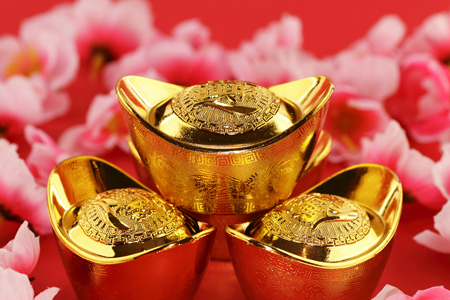
ตรุษจีน เป็นเทศกาลที่สำคัญที่สุดของจีน เพราะชาวจีนถือว่า วันตรุษจีน คือวันขึ้นปีใหม่ตามปฎิทินจีน เช่นเดียวกับสงกรานต์วันปีใหม่ไทย ดังนั้นชาวจีนจึงให้ความสำคัญกับเทศกาลนี้เป็นอย่างยิ่ง และมีการเฉลิมฉลองทั่วโลกโดยเฉพาะชุมชนขนาดใหญ่ของคนเชื้อสายจีน ซึ่งในแต่ละพื้นที่ก็จะมีพิธีเฉลิมฉลองแตกต่างกันไป สำหรับปี 2555 นี้ วันตรุษจีนตรงกับวันที่ 23 มกราคม
สำหรับที่มาของ วันตรุษจีน นั้น เชื่อกันว่าประเพณีนี้มีมานานกว่าสี่พันปีแล้ว จัดขึ้นเพื่อฉลองเทศกาลฤดูใบไม้ผลิ เดิมที่ไม่ได้เรียกว่าเทศกาลตรุษจีน แต่มีชื่อเรียกต่างกันตามยุคสมัย นั่นคือเมื่อ 2100 ปีก่อนคริสตศักราชจะเรียกว่า "ซุ่ย" ซึ่งมีความหมายถึงการโคจรครบหนึ่งรอบของดาวจูปิเตอร์ จนกระทั่งต่อมาในยุค 1000 กว่าปีก่อนคริสตศักราช เทศกาลตรุษจีนจะถูกเรียกว่า "เหนียน" หมายถึงการเก็บเกี่ยวได้ผลอุดมสมบูรณ์นั่นเอง
นอกจากนี้ วันตรุษจีน ยังมีชื่อเรียกอีกอย่างหนึ่งว่า "วันชุงเจ๋" ซึ่งหมายถึงเทศกาลดูใบไม้ผลิ หรือขึ้นปีเพาะปลูกใหม่ เพราะช่วงก่อนตรุษจีนนั้นตรงกับฤดูหนาว ไม่สามารถทำการเกษตรได้ ดังนั้นเมื่อเข้าสู่ฤดูใบไม้ผลิที่มีอากาศเหมาะสมแก่การเพาะปลูก ชาวจีนจึงสามารถทำนา ทำสวน ได้อีกครั้งหลังจากผ่านพ้นฤดูหนาวมานั่นเอง
ส่วนการกำหนด วันตรุษจีน นั้น ตามประเพณีเทศกาลตรุษจีนจะเริ่มตั้งแต่วันที่ 23 เดือน 12 ตามปฏิทินจันทรคติของจีน ไปจนถึงวันขึ้น 15 ค่ำเดือนอ้ายตามปฏิทินจันทรคติของจีน และถือว่าคืนวันที่ 30 เดือน 12 เป็นวันส่งท้ายปีเก่า ส่วนวันที่ 1 เดือน 1 คือวันชิวอิก หมายถึงวันแรกของฤดูใบไม้ผลิ
การเตรียมงานเพื่อการเฉลิมฉลองเทศกาลตรุษจีนนั้น จะเริ่มขึ้นตั้งแต่หนึ่งเดือนก่อน วันตรุษจีน (คล้ายกับวัน คริสต์มาสของประเทศตะวันตก) โดยผู้คนจะเริ่มซื้อข้าวของต่างๆ เพื่อประดับตกแต่งบ้านเรือน และเตรียมทำความสะอาดครั้งใหญ่ ตั้งแต่ชั้นบนลงชั้นล่าง เนื่องจากมีความเชื่อว่าจะเป็นการปัดกวาดสิ่งที่ไม่ดีออกไป ภายในบ้านทั้งประตู หน้าต่าง จะประดับประดาไปด้วยสีแดง และกระดาษสีแดงที่มีคำอวยพรให้อายุยืน ร่ำรวย อยู่ดีมีสุข ฯลฯ
จากนั้นครอบครัวจะร่วมรับประทานอาหารที่ล้วนแต่มีความหมายมงคลทั้งสิ้น เช่น กุ้งจะหมายถึงชีวิตที่รุ่งเรืองและความสุข เป๋าฮื้อแห้งหมายถึงทุกสิ่งทุกอย่างที่ดี สลัดปลาสดจะนำมาซึ่งความโชคดี จี้ไช่ (ผมเทวดา) สาหร่าย จะนำความร่ำรวยมาให้ และขนมต้ม (Jiaozi) หมายถึงบรรพชนอวยพร หลังจากทานอาหารค่ำแล้ว ทุกคนในครอบครัวจะนั่งกันจนเช้าเพื่อรอวันใหม่โดยการเล่นเกม เล่นไพ่ หรือดูรายการทีวีที่เกี่ยวกับ วันตรุษจีน และในวันนี้จะต้องไม่โกรธ ริษยา หรือ ไม่พอใจ เพื่อเป็นสิริมงคลที่ดีสำหรับปีที่กำลังจะมาถึง
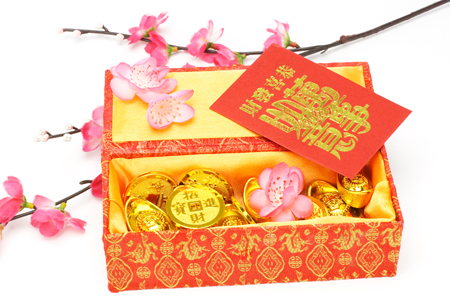
นอกจากนี้อีกสิ่งหนึ่งที่ถือเป็นสัญลักษณ์ของ วันตรุษจีน คือ "อั่งเปา" ซึ่งมีความหมายว่า "กระเป๋าแดง" หรือจะใช้คำว่า "แต๊ะเอีย" ซึ่งมีความหมายว่า "ผูกเอว" จากที่คนสมัยก่อนชอบร้อยเงินเป็นพวงผูกไว้ที่เอว โดยการให้อั่งเปานี้ คู่แต่งงานจะให้เงินเด็กๆ และผู้ใหญ่ที่ยังไม่ได้แต่งงานในซองสีแดง หลังจากนั้นทุกคน ในครอบครัว จะออกมาจากบ้านเพื่อกล่าวสวัสดีปีใหม่ในหมู่ญาติ และด้วยเพื่อนบ้าน ซึ่งคงคล้ายกับการที่ชาวตะวันตกพูดว่า "Let bygones be bygones" (อะไรที่ผ่านไปแล้วก็ให้มันผ่านไป)
วันพฤหัสบดีที่ 19 มกราคม พ.ศ. 2555


โยเกิร์ตเป็นผลิตภัณฑ์นมซึ่งผ่านขบวนการหมัก ทำให้มีรสเปรี้ยวและมีลักษณะกึ่งแข็งกึ่งเหลว ซึ่งมีต้นกำเนิดแถวเทือกเขาคอเคซัสของรัสเซีย ในโยเกิร์ตจะประกอบด้วยแบคทีเรียหลักๆ 2 ชนิดด้วยกันคือ Streptococcus thermophilus และ Lactobacillus bulgaricus ซึ่งแบคทีเรียเหล่านี้จะทำปฏิกิริยาเปลี่ยนนมให้เป็นโยเกริ์ต นอกจากนี้ในปัจจุบันยังมีการเติมแบคทีเรีย Bifido และ Lactobacillus casei ในโยเกิร์ตเพื่อเพิ่มคุณค่าทางอาหารอีกด้วย
คุณค่าทางอาหารของโยเกิร์ตนั้นจะมากหรือน้อย ขึ้นอยู่กับปริมาณแบคทีเรียที่ยังมีชีวิตในโยเกิร์ตในขณะที่รับประทาน ดังนั้นขบวนการผลิต การบรรจุ การเก็บ ตลอดจนการขนส่ง ล้วนแล้วแต่มีผลต่อคุณภาพของโยเกิร์ต ถึงแม้ว่าจะไม่มีมาตรฐานที่แน่นอนในการกำหนดคุณภาพของโยเกิร์ต แต่โยเกิร์ตที่ดีควรมีแบคทีเรียที่ยังมีชีวิต 100 ถึง 1000 ล้านตัวต่อปริมาณโยเกิร์ต 1 มิลลิกรัม
กระเพาะอาหารจัดเป็นปราการสำคัญในการกำจัดเชื้อโรค เนื่องจากความเป็นกรดใรกระเพาะสามารถฆ่าแบคที่เรียหลายๆชนิดก่อนที่เชื้อโรคเหล่านี้จะผ่านไปยังลำไส้ แบคทีเรียในโยเกิร์ตก็เช่นเดียวกัน จะถูกทำลายไปจำนวนหนึ่งเมื่อผ่านไปที่กระเพาะอาหาร ดังนั้นเราจึงจำเป็นต้องรับประทานโยเกิร์ตในปริมาณที่มากพอ เพื่อให้แบคที่เรียที่มีประโยชน์เหล่านี้จำนวนหนึ่งเหลือรอดผ่านไปยังลำไส้ได้ อย่างไรก็ตามในลำไส้เองก็มีแบคทีเรียมากมายหลายประเภทอาศัยอยู่ บางชนิดมีประโยชน์ต่อร่างกาย บางชนิดไม่มีประโยชน์ เมื่อเรารับประทานโยเกริ์ต แบคทีเรียที่อยู่ในโยเกิร์ตจัดเป็นสิ่งแปลกปลอมของร่างกาย แบคทีเรียเหล่านี้จึงไม่สามารถที่จะเกาะติดผนังลำไส้ได้ ดังนั้นจึงถูกขับออกจากลำไส้อย่างรวดเร็ว ในรูปของอุจจาระ
การรับประทานโยเกิร์ตให้ได้รับประโยชน์เต็มที่นั้นต้องรับประทานเป็นประจำและต้องเป็นปริมาณที่มากพอ เพื่อให้มีปริมาณแบคทีเรียในลำไส้ปริมาณหนึ่ง เนื่องจากแบคทีเรียใน โยเกิร์ตจะถูกขับออกจากร่างกายในเวลาไม่นานนัก
โยเกิร์ตจัดเป็นผลิตภัณฑ์ประเภท probiotics ซึ่งหมายถึงอาหารที่ประกอบด้วยจุลินทรีย์ที่ยังมีชีวิตซึ่งเป็นประโยชน์ต่อร่างกาย เนื่องจากสามารถปรับสมดุลของเชื้อจุลินทรีย์ในลำไส้ของผู้บริโภค ผลิตภัณฑ์ประเภท probiotics นอกจากโยเกิร์ตแล้ว ยังได้แก่ นมเปรี้ยว ผักดอง คีเฟอร์
เหตุผล 10 ประการ ว่า ทำไมโยเกิร์ตถึงเป็นอาหารชั้นยอดของร่างกาย
1. โยเกิร์ตย่อยง่ายกว่านม แม้ในคนที่แพ้โปรตีนหรือไม่มีสามารถย่อยนมได้ ก็สามารถกินโยเกิร์ตได้ เนื่องจากในขบวนการทำโยเกิร์ต นมจะถูกหมักและเปลี่ยนเป็นโมเลกุลที่สามารถย่อยได้ง่ายขึ้น และในขบวนการดังกล่าวจะเกิดแลคเตส ซึ่งเป็นเอนไซม์ที่ใช้ย่อยนม (น้ำตาลแลคโตส) สำหรับคนที่ไม่สามารถสามารถย่อยนมได้จะขาดเอนไซม์ชนิดนี้ นอกจากนี้ในขบวนการหมักดังกล่าวจะจะเกิดเอนไซม์ที่สามารถย่อยโปรตีนเคซีน ทำให้ง่ายต่อการดูดซึมและเกิดการแพ้น้อยลง จากการสังเกตเด็กที่ไม่สามารถย่อยนมได้ พบว่าสามารถกินโยเกิร์ตได้บ่อยครั้งโดยที่ไม่มีอาการท้องเสีย ในขบวนการทำโยเกิร์ต น้ำตาลนมแลคโตสจะถูกเปลี่ยนเป็นน้ำตาลกาแลคโตสและกลูโคส ซึ่งน้ำตาล 2 ชนิดนี้สามารถดูดซึมได้ง่ายแม้ในคนที่ไม่สามารถย่อยนมได้
2. โยเกิร์ตมีประโยชน์ต่อลำไส้ เนื่องจากในโยเกิร์ตประกอบด้วยแบคที่เรียแลคโตบาซิลัสที่เป็นประโยชน์ต่อลำไส้ ตลอดจนช่วยความเสี่ยงในการเกิดมะเร็งลำไส้ แบคทีเรียแลคโตบาซิลัสโดยเฉพาะ Lactobaciillus acidophilus จะช่วยเร่งการเจริญเติบโตของแบคทีเรียที่เป็นประโยชน์ต่อร่างกายในลำไส้ใหญ่และช่วยลดการเปลี่ยนน้ำดีเป็นกรดน้ำดีซึ่งเป็นสาเหตุหนึ่งของการเกิดมะเร็ง ปริมาณแบคทีเรียที่มีประโยชน์ในลำไส้จะช่วยลดความเสี่ยงของการเป็นโรคต่างๆที่บริเวณลำไส้ นอกจากนี้แบคทีเรียที่เป็นประโยชน์ต่อลำไส้พวกนี้จะทำลายสารอันตรายต่างๆ เช่น สารไนเตรตและไนไตรท์ ก่อนที่สารเหล่านี้จะเปลี่ยนเป็นไนโตรซามีนซึ่งเป็นสารก่อมะเร็งอย่างหนึ่ง
นอกจากโยเกริ์ต จะเป็นแหล่งของแบคทีเรียแล้ว ยังเป็นแหล่งที่อุดมไปด้วยแคลเซียม ซึ่งเป็นแร่ธาตุที่ช่วยยับยั้งการโตของเเซลล์ที่บุเยื่อบุลำไส้ที่มากจนเกินไปในบุคคลที่มีแนวโน้มที่จะเป็นมะเร็งลำไส้ใหญ่ นอกจากนี้แคลเซียมยังรวมตัวกับกรดน้ำดีซึ่งเป็นปัจจัยเสี่ยงในการเกิดมะเร็งโดยไม่ระคายเคืองต่อลำไส้ใหญ่ การบริโภคอาหารที่มีแคลเซียมสูง อาทิเช่นคนในแถบประเทศสแกนดิเนเวียนจะมีอัตราการเกิดมะเร็งลำไส้ลดลง จากการศึกษาพบว่าการกินแคลเซียมวันละ 1,200 มิลลิกรัม สามารถลดการเกิดมะเร็งลำไส้ได้ 75 %
3. โยเกิร์ตช่วยทำให้การดูดซึมของแร่ธาตุต่างๆดีขึ้น ขบวนการหมักโยเกิร์ตจะช่วยเพิ่มการดูดซึมแคลเซียมและวิตามินบี นอกจากนี้กรดแลคติกในโยเกิร์ตยังช่วยย่อยแคลเซียมในนม ทำให้ดูดซึมง่ายขึ้น
4. โยเกิร์ตช่วยเพิ่มภูมิคุ้มกันของร่างกาย จากการศึกษาพบว่าการบริโภคโยเกิร์ตวันละ 2 ถ้วยเป็นประจำ ตลอดเวลา 3 เดือนพบว่าระดับอินเตอร์เฟอรอนซึ่งเป็นสารในระบบภูมิคุ้มกันมีปริมาณเพิ่มขึ้น นอกจากนี้แบคทีเรียในโยเกิร์ตยังกระตุ้นการทำงานของเม็ดเลือดขาวในการทำลายเชื้อโรค บางการศึกษารายงานว่าพบสารที่มีฤทธิ์ต้านมะเร็งในโยเกิร์ต
5. โยเกิร์ตช่วยในขบวนการหายหลังการติดเชื้อที่ทางเดินอาหาร เชื้อไวรัสบางชนิด ตลอดจนอาการแพ้อาหารสามารถทำให้เซลล์เยื่อบุผนังลำไส้เสียหายได้โดยเฉพาะเซลล์ที่ทำหน้าที่ผลิตแลคเตส จึงส่งผลให้เกิดความผิดปกติในการดูดซึมน้ำตาลแลคโตสชั่วคราว นี่คือเหตุผลว่าทำไมในเด็กที่มีโรคติดเชื้อบริเวณทางเดินอาหารจะไม่สามารถย่อยนมได้ตามปกติหลังจากติดเชื้อ 1-2 เดือน และเนื่องจากโยเกิร์ตประกอบด้วยน้ำตาลแลคโตสน้อยลง แต่มีเอนไซม์แลคเตสมากขึ้น ดังนั้นจึงนิยมใช้โยเกิร์ตเป็นอาหารเพื่อรักษาอาการท้องเสีย เพราะจะช่วยให้อาการท้องเสียหายเร็วขึ้น สำหรับบุคคลที่ได้รับยาปฏิชีวนะ การรับประทานโยเกริ์ตจะช่วยลดผลกระทบของยาต่อแบคทีเรียที่เป็นประโยชน์ในลำไส้ใหญ่ (เนื่องจากยาปฏิชีวนะไม่ได้ออกฤทธิ์ทำลายเฉพาะแบคทีเรียที่เป็นอันตราย แต่จะทำลายแบคทีเรียที่เป็นประโยชน์แก่ร่างกายด้วย) ดังนั้นจึงมีการแนะนำให้กินโยเกิร์ตวันละ 1 ถ้วยในขณะที่ได้รับยาปฏิชีวนะ และรับประทานต่อเนื่องอีก 2 สัปดาห์หลังจากหยุดยาแล้ว จาการศึกษาในปี 1999 โดยกุมารแพทย์พบว่าแบคทีเรียแลคโตบาซลัสจะช่วยลดอาการท้องเสียหลังจากได้รับยาปฏิชีวนะ
6. โยเกิร์ตช่วยลดการติดเชื้อรา จากการศึกษาพบว่าการกินโยเกิร์ตวันละ 8 ออนซ์ทุกวันสามารถลดปริมาณเชื้อราที่ช่องคลอดได้ และยังช่วยลดการติดเชื้อราที่ช่องคลอดได้อีกด้วย
7. โยเกิร์ตเป็นแหล่งของแคลเซียม ในโยเกิร์ต 8 ออนซ์จะมีแคลเซียมมากถึง 450 มิลลิกรัม (ปริมาณเท่ากับแคลเซียมครึ่งหนึ่งที่ RDA แนะนำให้เด็กได้รับภายใน 1 วัน , และเท่ากับ 30-40 % ของปริมาณแคลเซียมที่แนะนำให้ผู้ใหญ่บริโภคภายใน 1 วัน) และเนื่องจากแบคทีเรียในโยเกริ์ตจะช่วยให้การดูดซึมแคลเซียมเป็นไปได้มากขึ้น ดังนั้นการกินโยเกิร์ตจะช่วยให้คุณได้รับแคลเซียมมากกว่าการกินนมในปริมาณเท่ากัน
8. โยเกิร์ตเป็นแหล่งของโปรตีนชั้นดี ในโยเกิร์ต 8 ออนซ์ประกอบด้วยโปรตีนประมาณ 10-14 กรัม ซึ่งเป็นปริมาณเท่ากับ 20 % ของความต้องการโปรตีนในแต่ละวัน และเมื่อเปรียบเทียบระหว่างนมกับโยเกิร์ตปริมาณเท่ากัน ในโยเกิร์ตจะมีโปรตีนปริมาณมากกว่า นอกจากโยเกิร์ตจะเป็นแหล่งที่อุดมไปด้วยโปรตีนแล้ว โปรตีนในโยเกิร์ตยังเป็นโปรตีนที่ย่อยง่าย
9. โยเกิร์ตช่วยลดระดับคลอเลสเตอรอล จากการศึกษาพบว่าโยเกิร์ตสามารถลดปริมาณคลอเลสเตอรอลได้เนื่องจากเชื้อจุลินทรีย์ในโยเกิร์ตสามารถกำจัดคลอเลสเตอรอลได้ และทั้งนี้โยเกิร์ตก็สามารถรวมตัวกับกรดน้ำดีซึ่งเป็นสารตั้งต้นของคลอเลสเตอรอลได้
10. โยเกิร์ตช่วยให้เด็กเจริญเติบโตได้ดี เนื่องจากในโยเกิร์ตเป็นแหล่งของโปรตีนที่ย่อยง่ายและกรดแลคติคในโยเกิร์ตจะช่วยเพิ่มประสิทธิภาพในการดูดซึมแร่ธาตุเข้าผ่านลำไส้
ข้อควรรู้เกี่ยวกับการเลือกซื้อโยเกิร์ต
1. โยเกิร์ตที่ดีที่สุดคือโยเกิร์ตรสธรรมชาติ เนื่องจากประกอบด้วยส่วนประกอบสำคัญเพียง 2 อย่าง คือ เชื้อจุลินทรีย์และนม แต่ในโยเกิร์ตรสอื่นจะมีการปรับปรุงรสชาติให้หวานขึ้นด้วยการเติมน้ำตาล นั่นหมายถึงว่าคุณจะได้รับพลังงานเพิ่มขึ้นด้วย (ทั้งนี้เราสามารถเพิ่มรสชาติให้กับโยเกิร์ตรสธรรมชาติของเราได้ด้วยการเติมผลไม้ต่างๆลงไปขณะรับประทาน)
2. ปริมาณแคลเซียม โยเกิร์ตที่ดีควรมีปริมาณแคลเซียม 35 – 40 % ต่อปริมาณที่แนะนำข้างถ้วยโยเกิร์ตขนาด 8 ออนซ์ และไม่ควรต่ำกว่า 30 %
3. ไม่ควรบริโภคโยเกิร์ตประภทที่ผ่านความร้อนหลังจากขบวนการทำโยเกิร์ตแล้ว ( จะเขียนไว้ข้างถ้วยว่า heat treated after culturing) เพราะโยเกิร์ตชนิดนี้จะถูกนำไปผ่านขบวนการพาสเจอไรซ์หลังจากที่เติมเชื้อจุลินทรีย์แล้ว ซึ่งทำให้คุณค่าทางอาหารของโยเกิร์ตลดลงเนื่องจากการพาสเจอไรซ์จะทำลายจุลินทรีย์และเอนไซม์แลคเตส ดังนั้นจึงไม่เหมาะสำหรับบุคคลที่ไม่สามารถย่อยนมได้ถึงแม้ว่าโยเกิร์ตชนิดจะเก็บได้นานกว่าโยเกิร์ตปกติ
แลคโตบาซิลัส- แบคทีเรียมหัศจรรย์
บริเวณลำไส้ใหญ่ของเรามีแบคทีเรียมากมายหลายชนิดอาศัยอยู่ และหนึ่งในแบคทีเรียทีเป็นประโยชน์แก่ร่างกายที่อาศัยอยู่บริเวณนี้คือ แบคทีเรียในกลุ่มแลคโตบาซิลัสซึ่งอาศัยน้ำตาลแลคโตสเป็นอาหาร และแบคทีเรียที่เรารู้จักกันดีคือ Lactobacillus acidophilus ซึ่งเจริญเติบโตได้ดีในภาวะเป็นกรดของลำไส้ใหญ่ นอกจากนี้แบคทีเรียชนิดนี้ยังมีประโยชน์ต่างๆต่อร่างกายของเรา ได้แก่
1. ช่วยในระบบการย่อยอาหาร เนื่องจากแบคทีเรียแลคโตบาซิลัสจะช่วยย่อยน้ำตาลแลคโตสในผลิตภัณฑ์จำพวกนม ซึ่งช่วยป้องกันการเกิดภาวะที่มีปริมาณแลคโตสมากเกินไปและช่วยลดปัญหาที่เกิดขึ้นในคนที่ไม่สามารถย่อยนมได้ แบคทีเรียแลคโตบาซิลัสยังช่วยเพิ่มประสิทธิภาพในการดูดซึมสารอาหารที่ลำไส้และช่วยกระตุ้นการบีบตัวของทางเดินอาหารที่เป็นกลไกตามธรรมชาติ ทำให้อาหารเคลื่อนผ่านสู่ลำไส้ได้ดีขึ้น
2. สร้างวิตามิน แบคทีเรียแลคโตบาซิลัสสามารถสร้างวิตามินบีและวิตามินเค
3. สร้างสารอาหารที่จำเป็นแก่ร่างกาย แบคทีเรียชนิดนี้จะช่วยสร้างกรดไขมันจำเป็นหรือกรดไขมันชนิดที่มีสายโมเลกุลสั้น ซึ่งเป็นสารอาหารสำคัญต่อเซลล์บริเวณลำไส้ นอกจากนี้ยังสามารถสร้างสารที่ช่วยต้านมะเร็งอีกด้วย
4. กระตุ้นระบบภูมิต้านทาน แบคทีเรียแลคโตบาซิลัสจะยับยั้งการเติบโตของของแบคทีเรียที่เป็นอันตรายและเชื้อรา อาทิเช่น ราแคนดิดา เนื่องจากแบคทีเรียประเภทนี้จะทำให้บริเวณลำไส้มีสภาวะเป็นกรดซึ่งแบคทีเรียที่เป็นอันตรายไม่สามารถอยู่รอดได้ นอกจากนี้แบคทีเรียแลคโตบาซิลัสยังสร้างไฮโดรเจนเปอร์ออกไซด์ซึ่งเป็นสารที่มีฤทธิ์ในการฆ่าเชื้อโรคต่างๆ
5. ต้านสารก่อมะเร็ง แบคทีเรียแลคโตบาซิลัสสามารถจับกับสารก่อมะเร็ง ทำให้สารดังกล่าวไม่สามารถทำอันตรายกับเซลล์ร่างกายได้อีก และLactobacillus bulgaricusซึ่งเป็นแบคทีเรียที่นิยมเติมในโยเกิร์ตนั้นมีคุณสมบัติในการต้านมะเร็งได้ดี นอกจากนี้แบคทีเรียแลคโตบาซิลัสยังสามารถจับโลหะหนักและกรดน้ำดีซึ่งเป็นสารก่อมะเร็งได้ ตลอดจนสามารถยับยั้งการเจริญเติบโตของแบคทีเรียที่ผลิตสารไนเตรต (ไนเตรตเป็นสารก่อมะเร็งชนิดหนึ่ง) และแบคทีเรียแลคโตบาซิลัสยังทำปฏิกิริยากับสารฟลาโวนอยด์ทำให้เกิดสารธรรมชาติที่สามารถต้านมะเร็งได้ดี
6. ป้องกันการเกิดโรคหลอดเลือดและหัวใจ เนื่องจากแบคทีเรียแลคโตบาซิลัสช่วยควบคุมระดับคลอเลสเตอรอลและกลีเซอไรด์ในกระแสเลือด
การรับประทานโยเกิร์ตเป็นอาหารเช้าจะช่วยทำให้สมองทำงานได้ดีขึ้น เนื่องจากในโยเกิร์ตมีกรดอะมิโนไทโรซีนปริมาณสูงซึ่งมีฤทธิ์กระตุ้นการทำงานของระบบประสาท และมีกรดอะมิโนทริปโตเฟนซึ่งทำให้ร่างกายเข้าสู่ภาวะสงบในปริมาณน้อย การเติมน้ำมันเมล็ดปอ (ประกอบด้วยกรดอะมิโนที่จำเป็นต่อสมอง) หรือพวกถั่ว (เป็นแหล่งของโปรตีนและช่วยรักษาระดับน้ำตาลในกระแสเลือด) ลงในโยเกิร์ตจะช่วยเพิ่มคุณค่าทางอาหาร ซึ่งจะช่วยให้พัฒนาการทางสมองของลูกน้อยเป็นไปได้ดียิ่งขึ้น
กำเนิดยาคูลท์
 ประมาณปี ค.ศ. 1930 ที่ประเทศญี่ปุ่น มีประชากรจำนวนมากที่ต้องล้มตายด้วยการขาดสารอาหาร ประสบปัญหาโรคในระบบทางเดินอาหาร ได้แก่ ท้องร่วง การติดเชื้อในลำไส้ อันสืบเนื่องมาจากการสาธารณสุขที่ยังไม่ดีพอ ประมาณปี ค.ศ. 1930 ที่ประเทศญี่ปุ่น มีประชากรจำนวนมากที่ต้องล้มตายด้วยการขาดสารอาหาร ประสบปัญหาโรคในระบบทางเดินอาหาร ได้แก่ ท้องร่วง การติดเชื้อในลำไส้ อันสืบเนื่องมาจากการสาธารณสุขที่ยังไม่ดีพอดร. มิโนรุ ชิโรต้า จึงมีความสนใจที่จะศึกษาวิจัยเกี่ยวกับแบคทีเรียกรดนม ด้วยแนวความคิดที่จะใช้เเบคทีเรียควบคุมแบคทีเรียด้วยกันเอง เเละได้ประสบความสำเร็จในการคัดเลือกเเบคทีเรียกรดนมที่มีความแข็งแรงที่สุดจากกว่า 300 สายพันธุ์ เป็นแบคทีเรียที่สามารถทนต่อกรดของกระเพาะอาหาร และน้ำดีจากตับที่มีฤทธิ์เป็นด่าง และยังมีชีวิตรอดอยู่ได้ในลำไส้คนเรา ซึ่งสายพันธุ์อื่นทนไม่ได้ ชื่อว่า แลคโตบาซิลลัส คาเซอิ สายพันธุ์ ชิโรต้า ด้วยแนวคิดที่จะให้ทุกคนมีสุขภาพที่ดีดร. มิโนรุ ชิโรต้า จึงได้นำแบคทีเรียตัวนี้มาผลิตเป็นผลิตภัณฑ์นมเปรี้ยวให้ชื่อว่า "ยาคูลท์"และเริ่มออกจำหน่ายเป็น ครั้งแรกที่ประเทศญี่ปุ่นเมื่อปี ค.ศ. 1935 ในปัจจุบันมีประชากรกว่า 26 ล้านคน ใน 32 ประเทศทั่วโลกที่ดื่มยาคูลท์เป็นประจำ |
วันพุธที่ 11 มกราคม พ.ศ. 2555
Nicholas Steno (1638-1686)

Despite a relatively brief scientific career, Nicholas Steno's work on the formation of rock layers and the fossils they contain was crucial to the development of modern geology. The principles he stated continue to be used today by geologists and paleontologists.
Steno was born as Niels Stensen, but he is better known by the Latinized forms of his name, Nicholas Stenonis or Nicholas Steno. A native of Copenhagen, Denmark, Steno left Denmark in 1660 to study medicine at the leading center for medical education of his time, the University of Leiden in the Netherlands. After brief stints in Paris and Montpelier, he moved to Florence, Italy in 1665. His studies in anatomy attracted the attention of the Grand Duke of Tuscany, Ferdinand II, who was also a patron of the sciences. Duke Ferdinand appointed Steno to a hospital post that left him ample time for his research. Steno was also elected to the Accademia del Cimento (Experimental Academy), a body of researchers inspired by Galileo's experimental and mathematical approach to science.
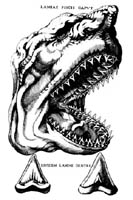 Steno's anatomical studies focused at first on the muscular system and the nature of muscle contraction -- for example, he used geometry to show that a contracting muscle changes its shape but not its volume. However, in October 1666, two fishermen caught a huge shark near the town of Livorno, and Duke Ferdinand ordered its head to be sent to Steno. Steno dissected it and published his findings in 1667. The figure at right shows the figure published by Steno of the shark's head and teeth (click on it to view a larger version). While examining the teeth of the shark, Steno was struck by their resemblance to certain stony objects, called glossopetrae or "tongue stones," that were found in certain rocks. Ancient authorities, such as the Roman author Pliny the Elder, had suggested that these stones fell from the sky or from the moon. Others were of the opinion, also going back to ancient times, that fossils naturally grew in the rocks. Steno's contemporary Athanasius Kircher, for example, attributed fossils to a "lapidifying virtue diffused through the whole body of the geocosm." Steno, however, argued thatglossopetrae looked like shark teeth because they were shark teeth, that had come from the mouths of once-living sharks, and come to be buried in mud or sand that was now dry land. There were differences in composition between glossopetrae and living sharks' teeth, but Steno used the "corpuscular theory of matter", a forerunner of atomic theory, to argue that fossils could be altered in chemical composition without changing their form.
Steno's anatomical studies focused at first on the muscular system and the nature of muscle contraction -- for example, he used geometry to show that a contracting muscle changes its shape but not its volume. However, in October 1666, two fishermen caught a huge shark near the town of Livorno, and Duke Ferdinand ordered its head to be sent to Steno. Steno dissected it and published his findings in 1667. The figure at right shows the figure published by Steno of the shark's head and teeth (click on it to view a larger version). While examining the teeth of the shark, Steno was struck by their resemblance to certain stony objects, called glossopetrae or "tongue stones," that were found in certain rocks. Ancient authorities, such as the Roman author Pliny the Elder, had suggested that these stones fell from the sky or from the moon. Others were of the opinion, also going back to ancient times, that fossils naturally grew in the rocks. Steno's contemporary Athanasius Kircher, for example, attributed fossils to a "lapidifying virtue diffused through the whole body of the geocosm." Steno, however, argued thatglossopetrae looked like shark teeth because they were shark teeth, that had come from the mouths of once-living sharks, and come to be buried in mud or sand that was now dry land. There were differences in composition between glossopetrae and living sharks' teeth, but Steno used the "corpuscular theory of matter", a forerunner of atomic theory, to argue that fossils could be altered in chemical composition without changing their form.
Steno's conclusion may seem so blatantly obvious as to be insignificant. Furthermore, Steno was not the first person to link "tongue stones" with sharks' teeth. Steno's contemporaries Robert Hooke and John Ray also argued that fossils were the remains of once-living organisms. The Italian naturalist Fabio Colonna had stated that "tongue stones" were shark teeth in a book published in 1616, and others had noticed the similarity even earlier. However, it is important to remember that shark teeth, and some other fossils such as relatively young clams and snails, are "easy fossils" -- they resemble living organisms very closely. A great many fossils do not look like familiar living organisms at all. They may be preserved in an unusual way; they may represent only a part or fragment of an organism; they may belong to extinct taxa; and/or their living counterparts may be unfamiliar or unknown. In Steno's time, in fact, the word "fossil" could mean virtually anything dug from the Earth. Naturalists did not always distinguish between "fossils" that resembled living organisms, and "fossils" such as crystals and ores that did form within the Earth. For all these reasons, the distinction between which objects found in rocks were and were not once-living organisms -- if, indeed, any of them were -- was not at all obvious in the seventeenth century.
Steno's work on shark teeth led him to the more general question of how any solid object could come to be found inside another solid object, such as a rock or a layer of rock. The "solid bodies within solids" that attracted Steno's interest included, not only fossils as we would define them today, but minerals, crystals, incrustations, veins, and even entire rock layers or strata. Steno's ideas on how these could form were published in 1669, under the title De solido intra solidum naturaliter contento dissertationis prodromus, or Preliminary discourse to a dissertation on a solid body naturally contained within a solid. (The book's title is often simply abbreviated to Prodromus.)
Assuming that all rocks and minerals had once been fluid, Steno reasoned that rock strata and similar deposits were formed when particles in a fluid such as water fell to the bottom. This process would leave horizontal layers. Thus Steno's principle of original horizontality states that rock layers form in the horizontal position, and any deviations from this position are due to the rocks being disturbed later. Steno stated another, more general principle in this way:
If a solid body is enclosed on all sides by another solid body, of the two bodies that one first became hard which, in the mutual contact, expresses on its own surface the properties of the other surface.In other words: a solid object will cause any solids that form around it later to conform to its own shape. Steno was able to show by this reasoning that fossils and crystals must have solidified before the host rock that contains them was formed. If a "tongue stone" had grown within a rock, it would have been distorted by the surrounding rock, in much the same way that a tree root is distorted by growing into a crack in the earth. Instead, the "tongue stone" must have been buried in soft sediments which hardened later. Veins (mineral-filled cracks) and many crystals, on the other hand, must have formed after the surrounding rock was a solid, because they often did show irregularities of form caused by having to conform to the surrounding solid rock. These, Steno argued, must have grown from fluids percolating within the Earth, in the same manner that crystals could be made to grow in chemistry experiments. Finally, in the case of strata, layers on top of a set of strata conform to the shape of lower layers. . . and therefore, in a set of strata, the youngest layers must be those of the top, and the oldest must lie on the bottom. This conclusion also follows from Steno's reasoning that rock strata form when particles fall out of suspension in a fluid -- but it also applies to rocks that do not form in this way, such as many igneous rocks. This is now referred to as Steno's law of superposition: layers of rock are arranged in a time sequence, with the oldest on the bottom and the youngest on the top, unless later processes disturb this arrangement. It is Steno's most famous contribution to geology.
Steno realized that other geological processes could create apparent exceptions to his laws of superposition and horizontality. He reasoned that the formation of caves might remove part of a lower layer, and that the collapse of a cave might transport large pieces of an upper layer downwards. He recognized that rocks might be uplifted by subterranean forces. Geologists now recognize that tilting, folding, and faulting may also complicate the analysis of a stratigraphic sequence. Molten rock may force its way through surrounding rocks and may sometimes squeeze between older rock layers, also forming an exception to Steno's law. However, such anomalies leave physical evidence in the disturbed rocks; for example, faulted rock layers may be cracked, broken, or metamorphosed along the fault line.
It should also be remembered that Steno's law is a statement of relative time, not absolute time: two rock layers, in principle, could have formed millions of years apart or a few hours or days apart. Steno himself saw no difficulty in attributing the formation of most rocks to the flood mentioned in the Bible. However, he noticed that, of the two major rock types in the Apennine Mountains near Florence, the lower layers had no fossils, while the upper ones were rich in fossils. He suggested that the upper layers had formed in the Flood, after the creation of life, while the lower ones had formed before life had existed. This was the first use of geology to try to distinguish different time periods in the Earth's history -- an approach that would develop spectacularly in the work of later scientists.
Steno essentially abandoned science after his conversion to Roman Catholicism in 1667, much to the dismay of some of his scientific colleagues. He was ordained as a priest in 1675. In 1677, he became a titular bishop, and spent the rest of his life ministering to the minority Roman Catholic populations in northern Germany, Denmark, and Norway. He never wrote the larger work for which his Prodromus was meant to serve only as an introduction. Yet his brief Prodromus was recognized as an important contribution in its own right; it was widely circulated and translated into English. The data and conclusions that Steno put forth in his "preliminary discourse" were enough to have earned him the title of "Father of Stratigraphy."
วันเสาร์ที่ 7 มกราคม พ.ศ. 2555
เอแคลร์

ขนมแป้งลูกเล็กที่เรียกว่า ‘เอแคลร์’ นั้นมีข้อมูลความเป็นมาอยู่น้อยนิด นักประวัติศาสตร์อาหารก็ได้แต่สันนิษฐานกันไปว่า น่าจะคิดปรุงขึ้นในช่วงศตวรรษที่ 19 โดยเจ้าของสูตรอาจเป็น Marie-Antoine Careme หัวหน้าห้องเครื่องประจำราชสำนักฝรั่งเศส ซึ่งได้คิดค้นทำขนมหน้าตาคล้ายๆกับเอแคลร์นี่แหละ
เอแคลร์เป็นภาษาฝรั่งเศส แปลว่า Lightning หรือ ฟ้าแลบ และไม่มีใครแน่ใจว่าทำไมมีชื่อแปลกๆอย่างนี้ได้ เลยเดากันไปว่า คงเป็นขนมก้อนเล็กที่เอาใส่ปากและกินได้รวดเร็วอย่างกับสายฟ้าที่แลบแปลบปลาบอะไรประมาณนั้น
หอเอนเมืองปีซา (The Leaning Tower of Pisa)

| |
| หอเอนเมืองปีซา ตั้งอยู่ที่เมืองปีซา ประเทศอิตาลี เป็นหอทรงกระบอก 8 ชั้น สร้างด้วยหินอ่อนสูง 181 ฟุต เริ่มสร้างเมื่อค.ศ. 1174 แต่การก่อสร้างต้องหยุดชะงักลงเมื่อก่อสร้างไปได้ประมาณ 4-5 ชั้น เนื่องจากพื้นดินใต้อาคารเริ่มยุบลงจากการที่รากฐานของอาคารไม่มั่นคงพอ อย่างไรก็ตามต่อมาได้มีการก่อสร้างเพิ่มเติมจนเสร็จสิ้นเรียบร้อยเมื่อปีค.ศ. 1350 ซึ่งมีการเปลี่ยนแปลงบางส่วนของโครงสร้างด้านบนไปจากแผนผังเดิมเพื่อถ่วงดุลกับการเอียงของหอ โดยรวมระยะเวลาก่อสร้างทั้งสิ้น 176 ปี แต่ตัวหอก็ยังเอนไปจากแนวตั้งฉากถึง 14 ฟุตปัจจุบันนี้ได้ปิดไม่ให้นักท่องเที่ยวขึ้นไปชมข้างบนแล้ว เนื่องจากว่าหอจะเอนลงเรื่อยๆ ซึ่งบรรดาวิศวกรกำลังหาทางที่จะหยุดยั้งการเอนและอนุรักษ์ให้มีสภาพเอียงไว้ให้อนุชนรุ่นหลังได้ชมไปอีกนานๆ สำหรับหอเอนปิซานี้ภายในมีเสาหินอ่อนที่สลักลวดลายด้วยฝีมือจิตรกรชื่อดังแห่งยุคได้สลักลวดลายไว้สวยงามมาก ณ ที่หอเอนปิซาแห่งนี้เป็นที่ที่กาลิเลโอขึ้นไปทำการทดลองทางวิทยาศาสตร์เกี่ยวกับแรงดึงดูดของโลก
|
วันพฤหัสบดีที่ 5 มกราคม พ.ศ. 2555
killer bees
Classification: Class: Insecta Order: Hymenoptera Family: Apidae Subfamily: Apinae |
|
| Mode(s) of Introduction: Honey bees are not native to the Western Hemisphere. European settlers brought most honey bees to the Americas approximately 400 years ago. However, European Honey Bees did not perform well in the tropical climate of South America. African Honey Bees were brought to the Western hemisphere in 1956, when the Brazilian government asked Dr. Warwick Kerr, a geneticist, to create a bee that could survive Brazil's tropical climate. The European Honey Bee had not been able to successfully withstand heat and predation. It was hoped that African Honey Bees, having proved themselves successful for millions of years in the tropics, could bred with the European bee. The goal was to create a bee which was gentle, yet successful in the tropics. However, in 1957, some of them got loose and set up housekeeping in the tropics of Brazil. They've been spreading ever since. Reason(s) Why it has Become Established: Because rainfall determines the availability and abundance of flora and food sources, the unpredictable rainfall in the tropics creates unpredictable availability of resources for bees. Therefore, Africanized bees' foraging stresses this unreliability and results in a more opportunistic bee. The bees forage, store their resources, and increase their chances of survival by collecting more pollen, committing more of their foraging cohort to pollen collecting, and swarming more often to areas of higher resources. Africanized bees might forage individually, shift their foraging from intensive and collective to gleaning, or searching of relevant resources individually, bit by bit. Because of this adaptability to unpredictable resources, the Africanized honeybee is categorized as an r-selected species. This means that they discover their habitat quickly, disperse readily to find other habitats if and/or when their current habitat has become inhabitable, use resources quickly and efficiently, and reproduce rapidly. | ||||||||||||||||||||
Many other basic Africanized Honey Bees traits include:
|

Competition among nectar- and pollen-feeding invertebrate pollinators and resource partitioning are affected by introduced Africanized Honey Bees. When Africanized Honey Bees compete with other species of honey bees for flowers, the Africanized bees may displace the other bees from the food sources. While over a short period of time, the abundance of other species of bee decreases and colony nectar and pollen harvest decreases, Africanized honeybees are negatively affected slightly over long periods. Competition is considered among one of the factors that are responsible for differences in foraging behavior and specialization in bees.
Africanized Honey Bees have similar predators as all other bees. Their most destructive predators are humans. Africanized honeybees are preyed on by ants, anteaters, and armadillos. Honey badgers, safari ants, bee wolves, and bears are also major predators. Additionally, predation causes disturbances that could affect swarming and absconding. If a colony has just settled and predation causes a disturbance, the colony might be forced to relocate immediately, affecting colony size and growth rates. Bees defend their nests from predators by biting or stinging. Africanized bees pursue their predatory intruders for much longer distances than European honeybees.
Additionally, parasites such as mites, fungi, and bacteria are supported by Africanized Honey Bees. Although Africanized bees are subject to the same diseases and mites that European bees are, Africanized bees have different biological processes and behaviors that affect the importance and visibility of the diseases and mites.
Benefit(s):
Africanized honeybees in the tropics directly influence 25-30% of the reproductive success of the flora. The flora depends on the bees for pollination, and in turn, flora provide seeds and fruit for their own reproductive success and as food for other organisms.
There are two views about the influences that Africanized Honey Bees have on crops. Pollination of crops can continue even if an area has been fully colonized by Africanized bees. The first argument contends that farmers' costs to produce crops increases because of the required public protection from Africanized bees and the increasing costs of purchasing European Honey Bees for pollination. The other view argues that Africanized honeybees are better pollinators than European honeybees because they emphasize brood rearing and colony growth instead of honey production. The shift in resource management allows Africanized honeybees to forage more for pollen than European bees. Therefore, Africanized bees can be regarded as superior pollinators. In Sinaloa Mexico, Africanized honeybees have invaded the area but have not caused any problems in crop harvests and production.
Threat(s):
Africanized Honey Bees are dangerous because they attack intruders in numbers much greater than European Honey Bees. Since their introduction into Brazil, they have killed some 1,000 humans, with victims receiving ten times as many stings than from the European strain. They react to disturbances ten times faster than European Honey Bees, and will chase a person a quarter of a mile.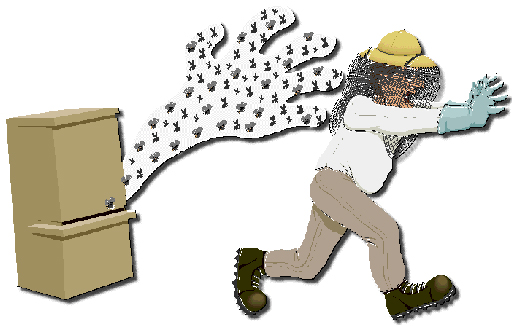
Other concerns with Africanized Honey Bees are the effects on the honey industry (with an annual value of $140 million dollars) and general pollination of orchards and field crops (with an annual value of $10 billion dollars). Interbred colonies of European and Africanized honey bees may be more aggressive, excessively abandon the nest, and not survive the winters. Further, beekeepers may not continue their business of honey production if faced with aggressive bees. The packaged bee and queen rearing industries are in the southern United States, which would affect the honey industry across the continent. Additionally, several researchers have shown that native solitary and social bee species are outcompeted by the introduced Honey Bee. It is possible that many species of native bees have or will go extinct as a consequence of the ecological dominance of these introduced bees.
Control Level Diagnosis:
Diagnosing a control level depends on the environmental conditions. As Africanized bees expand into temperate areas, their tropical adaptations are less advantageous. Africanized Honey Bee populations in temperate regions would not successfully establish a domain and therefore, a "Minimal Priority" control level should be diagnosed. However, a "Medium Priority" control level for North America's southern semitropical area is recommended. For example, in Argentina, Africanized bees dominate in the northern semitropical regions, but European bees dominate in the southern temperate area; in-between, there are hybrid zones where bees have varying degrees of African or European traits. A similar pattern may occur in the United States, with African traits dominating in extreme southern regions.
Control Method:
Even though the ecological range limits and economic consequences of the African Honey Bee migration into the United States are not precisely known, specialists agree that honey bees are economically important, and that sufficient biological information exists to develop adequate inventory and monitoring programs. Added benefits to honey bee monitoring programs are also important because bee colonies can also serve as excellent indicators of flowering plant productivity, ecosystem stability, and relative ecological health.
Because it will be more informed about the African Honey Bee, the U.S. beekeeping industry is not expected to suffer extensive damage from the invasion. It is anticipated that beekeepers will attempt to maintain European stock by drone-flooding, which involves maintaining large numbers of common European Honey Bees in areas where commercially-reared queen bees mate. This process would limit the mating possibilities between Africanized drones and European queens. Another strategy is frequent re-queening, where the beekeeper replaces the queen of the colony, thus assuring that the queens are European Honey Bees and that mating has also occurred with European drones. In addition, beekeepers will probably become involved in exterminating wild bee nests to protect their managed bees from resource competition.
| Finally, the public should maintain a healthy respect for all bee colonies and swarms. Any wild swarms found near residences or close to domestic animals (horses, cows, poultry, hogs, and dogs) must be suspect and reported to pest control operators, police, fire departments, and/or beekeepers. In all cases, the people who received the multiple stings, survived. Since the bees are potentially dangerous, people need to be aware that they are out there. The public already is exposed to yellow jackets and small wasps that are just as defensive as the Africanized Honey Bee’s. Therefore, killer bees are not so scary. Just stay away from bee hives. The bees will "never go away" nor can they be completely exterminated. Bees are responsible for the life of our trees, flowers and the food we eat. At least one meal per person per day is possible because of the bee. Therefore, learning about the Africanized Honey Bees and taking certain precautions can lower the risk of being injured by this new insect in our environment. |
|

 หอเอนเมืองปีซา (The Leaning Tower of Pisa)
หอเอนเมืองปีซา (The Leaning Tower of Pisa)